In 2025, solar microgrids are becoming a game-changing solution for powering farms across India and other agricultural economies. These decentralized energy systems use solar panels and battery storage to generate and supply electricity directly to farms, reducing dependence on unreliable grid connections and costly diesel generators. For farmers, especially in rural and semi-remote areas, solar microgrids are more than just an energy source—they are a tool for improving productivity, cutting costs, and enabling sustainable agricultural practices. As climate change impacts weather patterns and energy security becomes more critical, solar microgrids offer a reliable and eco-friendly alternative for modern farming.

What Are Solar Microgrids?
A solar microgrid is a localized energy system that operates independently or in conjunction with the main power grid. It typically consists of solar panels for generating electricity, battery storage systems for storing surplus energy, and a control system to manage distribution. On farms, these microgrids can power irrigation pumps, cold storage facilities, lighting, processing units, and even electric vehicles used for agricultural purposes. Unlike large centralized power systems, microgrids are designed to meet the specific needs of a farm or farming community, ensuring efficiency and resilience.
Why Farms Need Solar Microgrids
Agriculture is one of the most energy-intensive sectors, relying heavily on electricity for irrigation, crop processing, and storage. In many rural areas, farmers face frequent power cuts, voltage fluctuations, and high costs associated with diesel-powered equipment. Solar microgrids address these issues by providing a steady supply of renewable energy at a fraction of the long-term cost. Additionally, as governments phase out subsidies on fossil fuels and encourage cleaner energy, solar microgrids help farmers stay ahead of regulatory changes while reducing their environmental footprint.
Benefits of Solar Microgrids for Agriculture
-
Reliable Power Supply – Continuous electricity ensures irrigation and other operations run smoothly without interruption.
-
Cost Savings – After the initial investment, solar microgrids significantly reduce electricity bills and eliminate diesel expenses.
-
Environmental Sustainability – Solar power reduces greenhouse gas emissions and reliance on fossil fuels.
-
Improved Productivity – Reliable energy allows for better crop scheduling, efficient storage, and timely processing.
-
Community Empowerment – Shared microgrids in farming clusters can lower costs and foster cooperative farming models.
Role in Irrigation and Water Management
Irrigation is a critical application for solar microgrids. Solar-powered pumps can draw water from wells, rivers, or reservoirs without the need for diesel generators. By integrating microgrids with automated irrigation systems, farmers can schedule watering times based on crop needs and weather forecasts, optimizing water use and preventing wastage. This is especially beneficial in water-scarce regions, where efficient water management is essential for sustainable farming.
Cold Storage and Post-Harvest Management
One of the biggest challenges for farmers is preventing post-harvest losses due to inadequate storage facilities. Solar microgrids can power cold storage units, keeping perishable produce fresh for longer periods and enabling farmers to sell their crops when market prices are favorable. This reduces wastage, increases income, and enhances food security. Microgrids can also support grain drying and milling operations, adding value to raw produce before it reaches the market.
Integration with Modern Farming Technologies
Solar microgrids are compatible with various modern farming technologies such as automated feeders, climate-controlled greenhouses, and precision agriculture tools. Farmers can use the clean power generated to operate sensors, drones, and other smart devices that monitor soil conditions, crop health, and pest activity. This integration supports data-driven decision-making, leading to higher yields and more efficient resource use.
Government Support and Financing Models
In 2025, many governments are actively promoting the adoption of solar microgrids in agriculture through subsidies, low-interest loans, and tax incentives. Public-private partnerships are helping to bring microgrid technology to small and medium-sized farms that might otherwise struggle with the upfront investment. Innovative financing models, such as pay-as-you-go systems, allow farmers to pay for the energy they use rather than purchasing the entire system outright. These approaches are accelerating adoption and making clean energy more accessible to rural communities.
Challenges to Adoption
While solar microgrids offer numerous benefits, challenges remain. The high initial cost, though offset by long-term savings, can be a barrier for small-scale farmers. Technical expertise is required for installation, maintenance, and repairs, which may not be readily available in remote areas. Additionally, seasonal variations in sunlight can affect energy production, necessitating robust storage solutions. Addressing these challenges requires ongoing investment in training, infrastructure, and localized support networks.
Future of Solar Microgrids in Farming
Looking forward, advancements in solar panel efficiency, battery technology, and AI-powered energy management systems will make microgrids even more effective and affordable. Farmers will increasingly integrate renewable energy with precision agriculture, automated logistics, and sustainable water management. Community-based microgrid networks could link multiple farms, enabling resource sharing and collective bargaining power in the agricultural market. With continued innovation and policy support, solar microgrids are set to become a cornerstone of resilient, sustainable farming.
FAQs
What is the lifespan of a solar microgrid system?
Most systems last 20–25 years, with batteries typically needing replacement every 7–10 years.
Can solar microgrids work during cloudy or rainy seasons?
Yes. While output may be lower, battery storage ensures a continuous power supply during periods of low sunlight.
How much can farmers save using solar microgrids?
Savings vary, but many farmers report reducing energy costs by 50–80% compared to diesel or grid power.
Are there government subsidies for installing solar microgrids?
Yes. Many governments offer subsidies, tax benefits, and low-interest loans to promote renewable energy adoption in agriculture.
Click here to know more.
